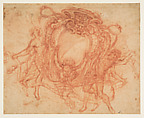Design for the Coat of Arms of a Cardinal with three Angels
Attributed to Pietro da Cortona (Pietro Berrettini) Italian
Possibly by Giovanni Francesco Romanelli Italian
Purchased as Anonymous, Italian, 17th century Italian
Not on view
This vibrant drawing in red chalk depicts the coat of arms of a cardinal, carried by three winged ignudi. While the design appears finished, many pentimenti (changes) have been left visible, especially where it concern the positioning of arms and legs of the figures. The compartment at the center of the cartouche has not been filled with a specific crest, which means that an identification of the project is as of yet not possible. The design of the cartouche suggests a moment of transition from the early Baroque to the more flamboyant designs of the second half of the seventeenth century. Stylistically, the sheet can almost certainly be attributed to Pietro da Cortona, or an artist of the in his circle in Rome during the second quarter of the seventeenth century.
The heraldic subject matter of the drawing is typical for the Baroque period when the patrons of the numerous important architectural commissions were often memorialized on buildings by way of their coats of arms, which were incorporated in the decoration schemes of façades or interiors in stone sculpture, stucco, or illusionistic fresco painting. As a result, the design of coats of arms (targhe in Italian) became a subject of interest in its own right. Various seventeenth-century Italian artists created ornament print series with designs for cartouches and coats of arms in the latest fashions, and publishers like the De' Rossi family documented examples by artists such as Gian Lorenzo Bernini, Pietro da Cortona and others in large dedicated volumes.
Due to rights restrictions, this image cannot be enlarged, viewed at full screen, or downloaded.


